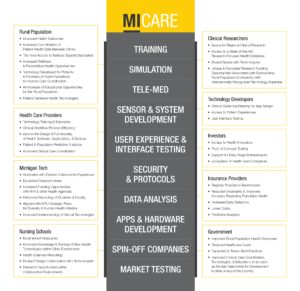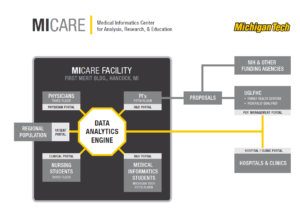Beginning in 2014, I have worked on designing and proposing the establishment of a collaborative Center, called the Medical Informatics Center for Analysis, Research, and Education or MICARE.
MICARE’s initiative takes an inter-sectional approach, bringing together research, education, health monitoring, and technology. MICARE is unlike any other center because it focuses on the patient and the health of our population through a unique set of multidisciplinary viewpoints; the physician, the nurse, the scientist, the informaticist, and the technologist. By collaborating and co-influencing each other, results improve for all. For example, many health care technologies have been developed without the guidance and practical input from the physician. As a result, they have been underutilized at best.
With MICARE, we create an ecosystem of diverse experts collaborating on innovative health technologies, all while focusing on improved health outcomes for patients and targeted populations. A center, containing a high-level of experience and expertise throughout clinical and technical fields, embedded in collaborative health care technology research, produces a breeding ground of technical innovation which span benefits to the patient population, health care providers, developers, clinical researchers, and more. The Innovation Benefits Model associated with MICARE is provided below.

MICARE Innovation Benefits Model
Immediate Impact
The MICARE Center is currently operational as a virtual center, developing innovative algorithms and technologies, such as a skin cancer detection application using a smartphone, and a Parkinson’s Disease (PD) tremor sensor monitoring and medication reporting system. The reports, accessible to PD individuals, their caregivers, primary physicians, and Parkinson’s specialists, will provide more reliable data, improving clinical decisions, care-coordination, and quality of life for those with PD.
MICARE requires a shared facility to foster an integrated environment, permitting clinicians, scientists, informaticists, and technologists to work together in developing health care solutions for rural populations. A shared center would include a strong clinical presence, enhancing the design, development, testing, and implementation of innovative technologies, resulting in improved healthcare delivery.
The full impact of MICARE can be realized only by establishing a collaborative environment blending clinic, simulation labs, research, and education space. Because all the “components” of MICARE already exist, with only the physical space missing, the return on MICARE’s initial investment will be both rapid and sustained. Interdisciplinary health research, education, along with population health management and monitoring, would be enhanced as a result. An example of MICARE’s proposed data analytics engine diagram facilitating human health research can be seen in the illustration below.

MICARE Data Analytics Engine Configuration
For more information on the MICARE Initiative, ways you can become involved or contribute to the Center, and a 3D video of the proposed MICARE space, please visit http://micare.mtu.edu.